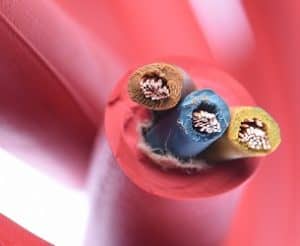Do you really need to think about jacketing material when working with a cable assembly manufacturer to design a custom cable?
A cable assembly manufacturer can not only design a cable assembly, they can help you determine what type of jacketing material is appropriate for your application. While it might be tempting to overlook the jacketing on your cables, you could be missing out on some added value and functionality, including:
- Enhanced Overall Flexibility
- Better Flexibility in Low Temperatures
- Quick Identification
- Elastic Memory
- Chemical Resistance
- Resistance to Extreme Heat or Flame
As long as you think carefully about how and where the cable assembly will be used, you can address many of the environmental challenges that can affect the durability and safety of the finished cable by selecting the proper jacketing material.
Durable Cables in Challenging Environments
A cable’s outer jacketing is often the first line of defense against elements like heat, cold, moisture, UV rays, chemicals, and other substances that could affect the wire’s functionality. As with any custom wire, it’s important to consider all of the requirements for your environment and application. For example, jacketing made from PVC is a low-cost option that can handle the stresses of moderate daily use and withstand temperatures ranging up to 105 degrees Celsius. However, it would not be a good choice for a cable that must function in extreme heat or that is subject to heavy wear and tear – PU is a better choice for that type of environment.
Cables with Enhanced Safety Features
A custom cable assembly manufacturer can help you choose a jacketing material that is specifically designed to meet the needs of your equipment. This goes beyond the function and durability of the cable to the question of how safe it is. The jacketing of a cable assembly protects the conductor from stresses that would cause failure. However, you can also choose materials that are resistant to fluids and chemicals that could cause shorts or corrosion which could cause the wire to fail prematurely. In addition, jacketing material can be designed to be resistant to flame, which can help prevent the spread of fire.
Cable Aesthetics
How a cable looks might not be the top priority when discussing jacketing materials with a cable assembly manufacturer, but a cable’s appearance should not be overlooked. Altering the appearance of cable jacketing materials is more than just designing a cable that looks nice. Choosing matte or shiny finishes and specific colors can also be practical, because these features allow the finished cable to be quickly and easily identified. Cable jacketing can be produced in colors that match the appropriate equipment or signal whether it carries electricity or data. In addition, the cable’s texture can make it easier to grip which could be a desired feature in some environments.
Conclusion
When designing a cable assembly, selecting the right jacketing material for your application and environment can often be just as important as choosing the right conductor. A reputable cable assembly manufacturer can offer many options to ensure your finished cable meets your requirements for durability and functionality. Clearly communicating your environmental concerns along with technical requirements will result in a custom cable that offers you the performance and durability you expect. If you have any questions about jacketing materials, please feel free to contact the team at Meridian Cable.